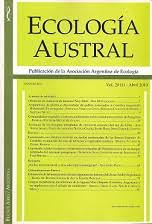View Item
- xmlui.general.dspace_homeCentros Regionales y EEAsCentro Regional Entre RíosEEA ParanáArtículos científicosxmlui.ArtifactBrowser.ItemViewer.trail
- DSpace Home
- Centros Regionales y EEAs
- Centro Regional Entre Ríos
- EEA Paraná
- Artículos científicos
- View Item
Fitotoxicidad de un formulado comercial de glifosato sobre Lemna gibba L.
Abstract
El objetivo fue evaluar la fitotoxicidad de un formulado comercial de glifosato (sal potásica al 62%, equivalente a 506 g p.a./L) sobre Lemna gibba, a campo y en laboratorio. El estudio a campo se desarrolló en un embalse asociado a un ambiente agrícola. Allí se realizó un análisis temporal, con observaciones en cuatro momentos en función de la proximidad a la fecha de aplicación del herbicida en el lote agrícola y al primer evento de precipitación que
[ver mas...]
El objetivo fue evaluar la fitotoxicidad de un formulado comercial de glifosato (sal potásica al 62%, equivalente a 506 g p.a./L) sobre Lemna gibba, a campo y en laboratorio. El estudio a campo se desarrolló en un embalse asociado a un ambiente agrícola. Allí se realizó un análisis temporal, con observaciones en cuatro momentos en función de la proximidad a la fecha de aplicación del herbicida en el lote agrícola y al primer evento de precipitación que generó escurrimiento. La fitotoxicidad se evaluó sobre biomasa seca por fronde (BF) y contenido total de clorofila (CTC). Durante 15 días, en condiciones controladas se ensayaron 8 tratamientos con exposición a concentraciones de glifosato que variaron entre 0 y 15 mg/L. Se determinó el crecimiento poblacional, CTC y longitud de raíz. A campo, la inhibición significativa de BF y CTC registrada a posteriori del evento de precipitación no se pudo asociar a concentraciones de glifosato en el cuerpo de agua. Estos efectos podrían ser atribuidos al escurrimiento de otros agroquímicos que no fueron analizados. En laboratorio se verificó efecto fitotóxico sobre la longitud radical a partir de concentraciones de 0.2 mg/L. La información generada contribuye al diagnóstico de riesgo de contaminación por herbicidas en agroecosistemas. Los resultados obtenidos no son concluyentes e indican la necesidad de profundizar este tipo de estudios, dada la complejidad que reviste la investigación del efecto de agroquímicos en el ambiente.
[Cerrar]
The aim was to evaluate
the phytotoxicity of one commercial formulated glyphosate (potassium salt, 62%, 506 g e.a./L) on Lemna gibba
in field trials and in controlled laboratory conditions. The field study was conducted in a lentic water body
associated with an agro-environment (Entre Ríos, Argentina). We conducted a temporary analysis with
observations at four moments according to the proximity of the date of herbicide application in the
[ver mas...]
The aim was to evaluate
the phytotoxicity of one commercial formulated glyphosate (potassium salt, 62%, 506 g e.a./L) on Lemna gibba
in field trials and in controlled laboratory conditions. The field study was conducted in a lentic water body
associated with an agro-environment (Entre Ríos, Argentina). We conducted a temporary analysis with
observations at four moments according to the proximity of the date of herbicide application in the agricultural
lot and the first rainfall event that caused runoff. The phytotoxicity was evaluated on the dry biomass of frond
(BF) and total chlorophyll content (TCC). In the laboratory, eight treatments were tested according to different
concentrations of glyphosate (0 to 15 mg/L). The phytotoxic effects were assessed on the growth rate (GR), TCC
and root length. In field study, the significant inhibition of BF and TCC observed in the subsequent sampling
to the rainfall event that caused runoff could not be associated with concentrations of glyphosate in the body
of water. These effects may be a�ributed to runoff of others agrochemicals not analyzed. In the laboratory, a
significant reduction of root length was detected, while no significant differences were observed in GR and TCC
between treatments. The information generated contributes to the diagnosis of risk herbicide contamination
in agroecosystems. The results obtained are not conclusive and show the need to deepen this type of studies,
given the complexity of the agrochemicals research and their effects on the environment.
[Cerrar]

Author
Sione, Silvana María José;
Ramírez, Adriana C.;
Sasal, Maria Carolina;
Paravani, Enrique V.;
Wilson, Marcelo German;
Gabioud, Emmanuel Adrian;
Polla, Wanda Marina;
Repetti, María Rosa;
Oszust, José Daniel;
Fuente
Ecología austral 28 (1) : 001-011. (Abril 2018)
Date
2018-04
Editorial
Asociación Argentina de Ecología
ISSN
1667-782X
0327-5477 (Online)
0327-5477 (Online)
Formato
pdf
Tipo de documento
artículo
Palabras Claves
Derechos de acceso
Abierto
 Excepto donde se diga explicitamente, este item se publica bajo la siguiente descripción: Creative Commons Attribution-NonCommercial-ShareAlike 2.5 Unported (CC BY-NC-SA 2.5)
Excepto donde se diga explicitamente, este item se publica bajo la siguiente descripción: Creative Commons Attribution-NonCommercial-ShareAlike 2.5 Unported (CC BY-NC-SA 2.5)


